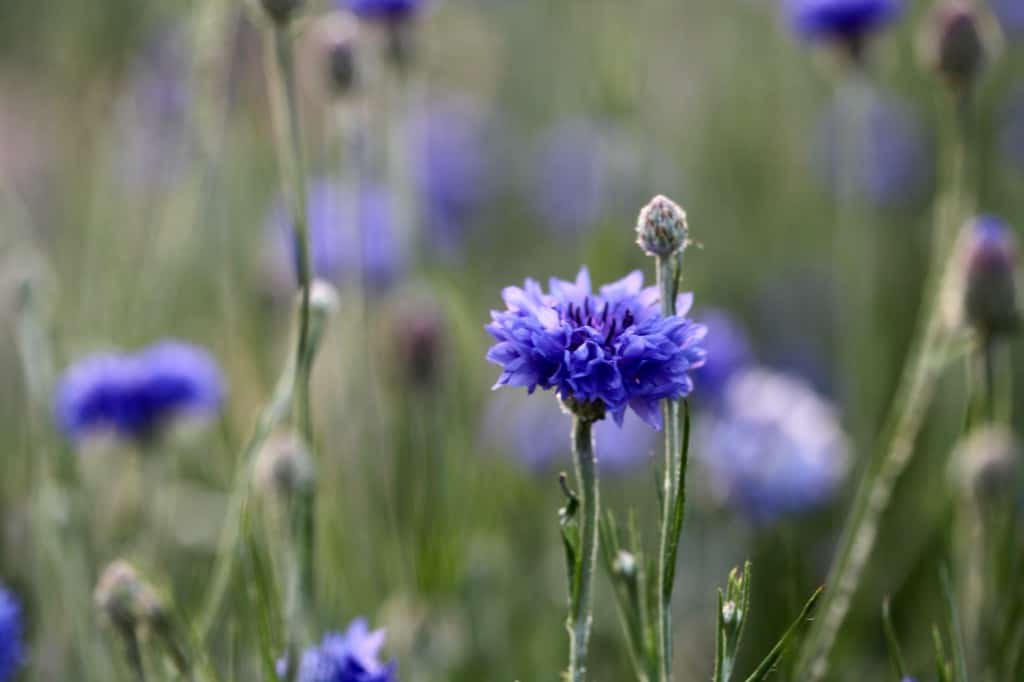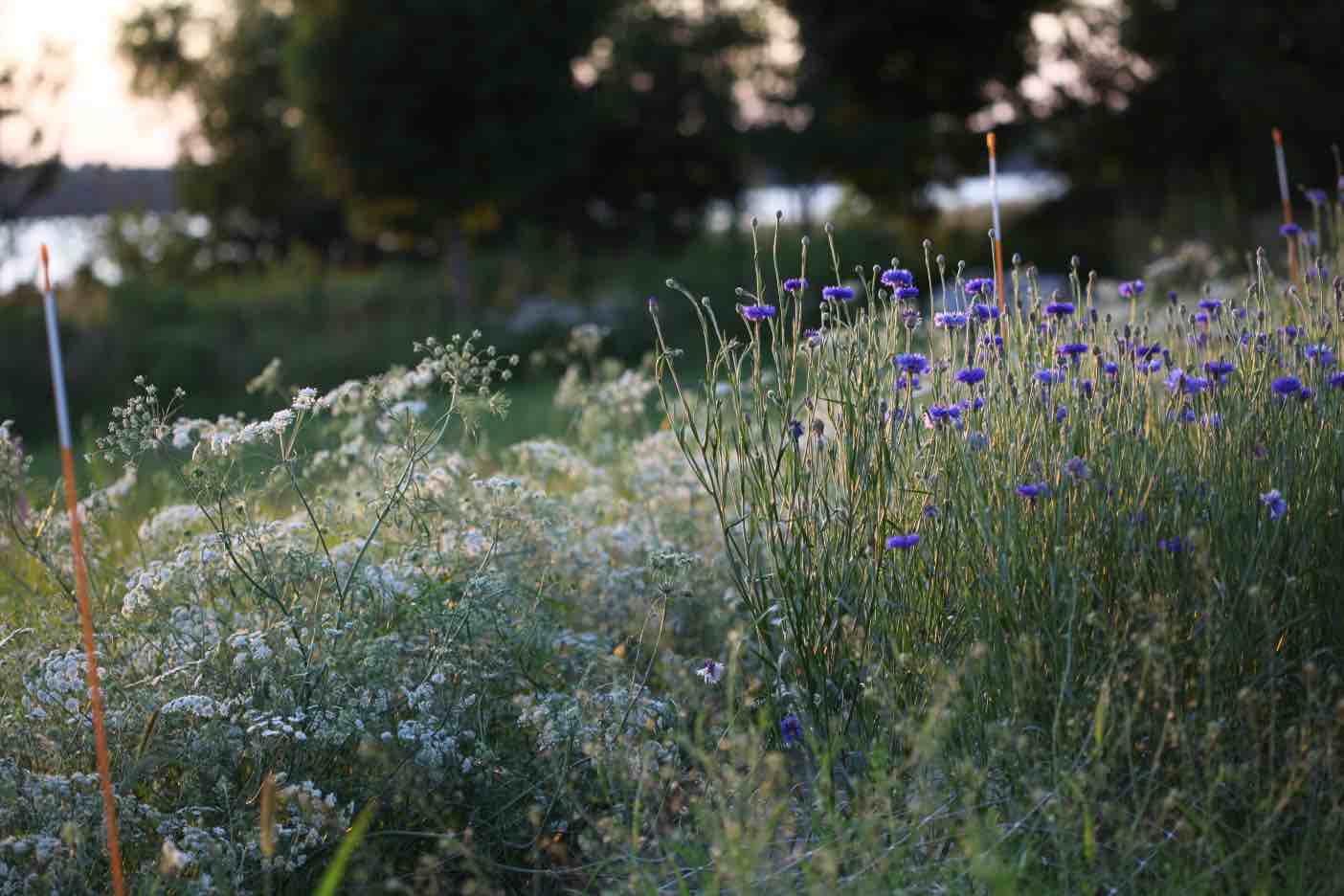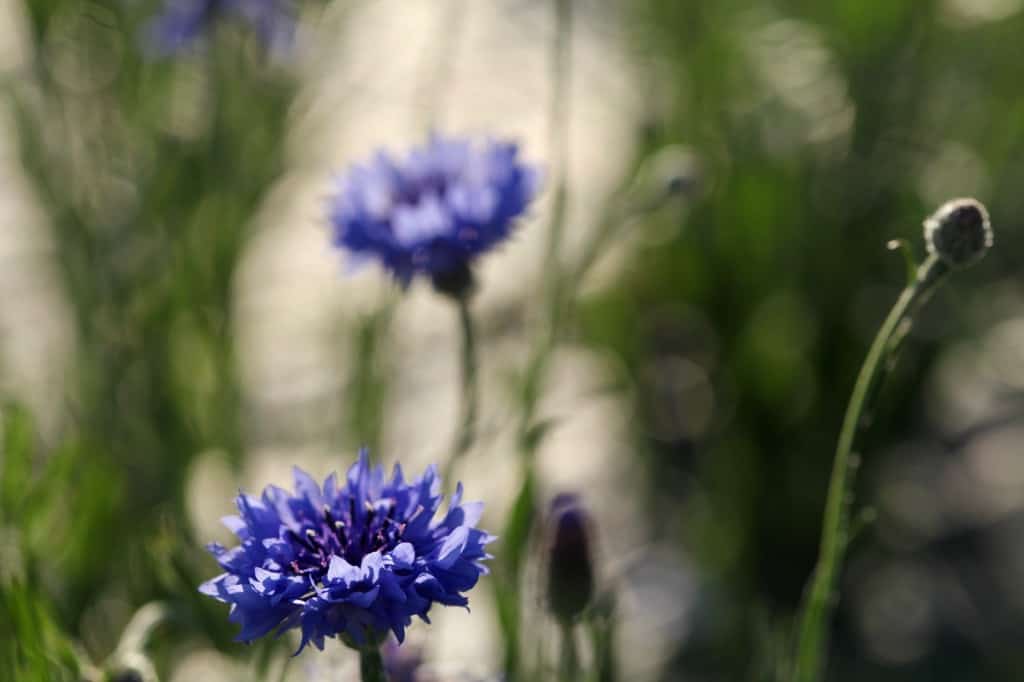Bachelor buttons, also known as cornflowers, are a popular choice for the flower garden, due to their vibrant blue colors and fringed petals. These adorable blue pinwheel shaped blooms will often return to the garden season after season, after only one planting. As you explore the world of flowers, you may find yourself wondering if bachelor buttons are perennials.

Are Bachelor Buttons Perennials?
To answer this question, it's important to know that there are actually two types of bachelor buttons. The plant has both annual and perennial varieties. Centaurea cyanus is the annual variety, while Centaurea Montana is the perennial variety. Both types of plants offer beautiful pinwheel shaped flowers, and interesting foliage, which make them perfect for cutting.
I grow both types of flowers in my garden. Every year the annual bachelor buttons are planted from seed for cutting, and placed in long rows mixed in with other annuals.
The perennial plants however are not planted every year, as they return to the garden, in the same place where they were originally placed. They are grown in a perennial bed.
The annual variety, Centaurea cyanus, is typically associated with the vibrant blue flowers often seen in cottage gardens and cut flower arrangements. Although an annual plant, this species of bachelor buttons often returns to the garden as well, through the process of reseeding, therefore appearing as if it is a perennial plant.
It should also be noted, that although Centaurea cyanus is generally considered to be a hardy annual, it very occasionally can be perennial in much warmer locations, such as zones 8 through 10.

In contrast, the perennial variety, Centaurea montana, is known for it's sweet, lightly scented airy blue flowers. This herbaceous perennial will return to the garden year after year, and will also reseed, establishing it's place in the garden.
The difference between annual and perennial plants can determine just how much work and time you have to devote to your garden, although both types are very low maintenance. Both varieties of bachelor buttons offer unique benefits and challenges to the discerning gardener.

What Are Bachelor Buttons?
Bachelor buttons belong to the Family Asteraceae, and Genus Centaurea.
Popular common names for annual bachelor buttons, or Centaurea cyanus, include cornflower, bachelor's buttons, and bachelor buttons.

Perennial bachelor buttons, or Centaurea montana, have many common names. These include corn flower, mountain cornflower, mountain bluet, perennial cornflower, montane knapweed, bachelor's button, and bachelor buttons.

Annual Bachelor Buttons
One of the most common species of bachelor buttons is Centaurea cyanus, the annual bachelor button plant. This popular plant is known for it's vivid blue petals, although it is also found in shades of purple, pink, white and red.
These annual flowers have a distinct, frilly appearance with a central thistle-like flower head surrounded by a ring of petals. These annual plants are favored for their hardy nature, and ability to thrive in poor soil conditions.
The annual flowers have no scent, compared to their perennial cousins.
These are some of the first spring flowers that I plant out, due to their hardiness and ability to withstand spring frosts in our zone 5 garden. They are a favorite cut flower due to their reliability, and ability to produce flowers all season long.
Annual bachelor button flowers are a popular choice for cottage gardens, and the cutting garden. These annual plants are taller varieties than their perennial counterparts. They make excellent cut flowers, and are popular in carefree flower arrangements.
Their bright and cheerful blooms not only add a splash of color to gardens, but also attract beneficial insects such as bees and butterflies, making them an important addition to any outdoor space.

| Annual Bachelor Buttons (Botanical Name: Centaurea Cyanus) | Characteristics |
| Life Cycle | Completes in one year (see exception ✿), self seeds |
| Growth Height | 3 feet tall |
| Flowering Time | Early summer to late summer |
| Flower Colors | Blue, pink, white, purple |
| Sun Preference | Full sun location |
| USDA Hardiness Zones | Zones 2 to 11 |

Perennial Bachelor Buttons
The perennial Centaurea montana is also popular, and yet another great choice for the cottage garden setting. This perennial bachelor's button plant is valued for it's ease of care, beautiful and distinctive blooms, and ability to bring a wildflower-like charm to a variety of garden settings.
The flowers of perennial bachelor buttons are vibrant and fringed, and most commonly blue. There are varieties with pink and white blooms as well.
As a perennial, Centaurea Montana returns to the garden each year, forming a mounding plant. The plant will spread through it's root system, as well as through self seedling, although not as aggressive with self propagation as some other perennials.
Centaurea Montana is popular in garden borders, and wildflower meadows, attracting pollinators like bees and butterflies to the garden. This plant is also a great choice for rock gardens due to it's mounding and hardy nature.

| Perennial Bachelor Buttons (Botanical Name: Centaurea Montana) | Characteristics |
| Life Cycle | Returns year after year |
| Growth Height | 1 to 2 feet tall |
| Flowering Time | Early summer |
| Flower Colors | Blue, pink, white, purple |
| Sun Preference | Full sun, will also tolerate partial shade |
| USDA Hardiness Zones | Zones 3 to 9 |

The Importance Of Knowing A Plant's Lifecycle
Understanding a plant's lifecycle is a key component of garden planning.
Differentiating between annual and perennial plants is important, enabling gardeners to create a garden that is not only aesthetically pleasing, but also ecologically balanced and resource efficient.
Perennials return to the garden year after year, and grow larger over time, so make sure to provide space for your perennial plants. Annuals on the other hand only last one year, and will need to be replanted, so don't need extra space.

Perennials may have a higher initial cost, especially if buying starter plants instead of seeds. Annuals most often are started from seed, so are less expensive initially, however will need to be replanted every year if you want to continue to grow them, increasing costs (unless you save your own seeds).
I like to harvest and collect flower seeds from both my annual and perennial flowers. It's an economical way of perpetuating flowers in the garden, and you can gather tons of seeds from your plants for the next growing season.
Collecting seeds is also a great way to grow flowers which are well adapted to your growing location and climate. They will become more adapted over time.



Frequently Asked Questions
What Is The Best Time To Plant Bachelor Button Seeds?
The best time to plant bachelor button seeds is dependent on the chosen planting method.
- You can direct sow both annual and perennial bachelor button seeds into the garden in late fall or early spring before the last frost date. This exposes the seeds to cold temperatures which will naturally stratify them.
- The seeds can also be started indoors in cell trays in late winter, and the young seedlings can be planted out in late spring.
- Seeds can also be winter sown. This involves planting in specially prepared winter sowing containers, and placing them outside for the winter.

Will Bachelor Buttons Reseed Themselves?
Bachelor buttons are known to self-seed, especially the annual variety, but also the perennials as well. Since the annual plants are hardy annuals, the seeds will often survive the cold winter weather, and germinate the following spring.
The degree to which the plants reseed will vary, depending on a number of different factors. This includes factors such as climate, soil conditions, and even garden maintenance.
Deadheading and pruning the spent flower heads is fairly effective at reducing self seeding.

Are Bachelor Buttons Known To Be Invasive?
In general, bachelor buttons are not considered to be invasive plants in most locations. They are relatively easy to control in the garden, and respond well to deadheading and pruning which can prevent reseeding.
Any volunteer plants are easily plucked from the garden to be transplanted elsewhere, or are generally welcomed wherever they grow.

Conclusion
Bachelor buttons are easy to grow flowers which can add a pop of color to your garden and your vase.
While Centaurea cyanus are traditionally known to be annuals, these vibrant flowers can exhibit perennial characteristics in certain climates.
Regardless of whether you choose to grow the annual or the perennial varieties, or both, you'll enjoy these low maintenance, pollinator friendly flowers, that add color to the garden, wherever they are grown.
Their ability to reappear year after year, either as true perennials or through self-seeding, offers a sense of continuity and surprise to your garden landscape. I love it when they appear in unexpected places, for that little bright spot of color that they give.
Consider planting some bachelor buttons in your garden this season. Whether you are a seasoned gardener, or a budding beginner, the adaptability and charm of bachelor buttons makes them a delightful addition to any garden or landscape.

Have you ever wondered if bachelor buttons were annuals or perennials? Be sure to leave a comment below to share your thoughts!
Other Posts You May Like:
PIN IT FOR LATER!










Leave a Reply